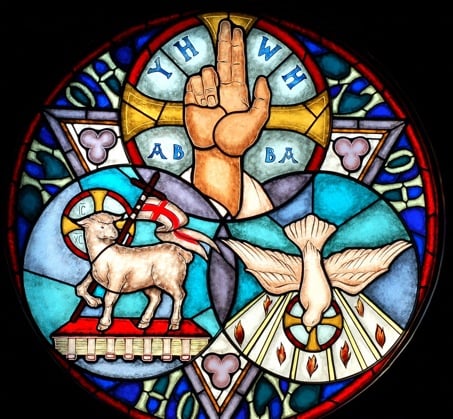Chances Are
Chances Are
When we numerate the principal English names and titles by which we know the Trinity, using the most well-established systems of gematria, we obtain several numbers also found within a single geometic figure (for simplicity’s sake I am ignoring the Greek and Hebrew words here). Was it merely the winds of chance that blew them there? The mathematics involved in performing a full analysis are no doubt beyond all but a trained probability theorist. However, within certain limits, a very simple estimate of probability can be given.
An Estimate of Probability
The probability of numerical values related to the Trinity coinciding with important numerical properties of the Creation snowflake can be reduced to the probability of selecting certain numbers from a large pool (replacing the numbers after selection)—so called ‘ball-in-a-bag’ problems—which are tackled using the binomial theorem. The formula is as follows:

How the Numbers Were Chosen
Many names are used to describe the Trinity, but for the purposes of this estimate, I will use only the names we ascribe to the three Persons, using them as they appear within the NIV Bible.
1. The Lord God. Accepted shorter versions of this name are: Lord God, The Lord, Lord, God.
2. Jesus Christ. Accepted shorter versions of this name are: Jesus, Christ
3. The Holy Spirit. Accepted shorter versions of this name are: Holy Spirit, Spirit and we also use Holy.
This gives us 12 words and phrases to numerate.
Next I will calculate numerical values for these twelve names. For this exercise I will use only the three systems of numeration accepted in Hebrew gematria. the standard (absolute), ordinal and reduced values. There are twelve names in use, so we have 3 x 12 = 36 possible numbers encoded within the snowflake. Therefore the number of trials (n) = 36.
The numerical values are shown below:
1. The Lord God = 468, 108, 54.
Lord God = 255, 75, 39.
The Lord = 397, 82, 37.
Lord = 184, 49, 22.
God = 71, 26, 17
2. Jesus Christ = 925, 151, 43.
Jesus = 515, 74, 11.
Christ = 410, 77, 32
3. The Holy Spirit = 1489, 184, 76.
Holy Spirit = 1276, 151, 61.
Holy = 798, 60, 24.
Spirit = 478, 91, 37
These thirty-six numbers can be taken to be the ‘results of the trials’.
The Probability of Success and Failure
The list of calculated values ranges from 11 to 1489, so I will take 1479 (1489 - 10) as the pool of numbers.
There were 36 ‘trials’. The successful trials were those where the numbers found within the list of calculated numerical values are also derived from structural properties of the Creation Snowflake. I have chosen easily the three most important structural properties for the calculation:
1. The number of units forming each stage of the snowflake. These are 37, 151, 373, 1279.
2. The number of units forming the outline of each stage of the snowflake. These are 24, 60, 108, 252.
3. The number of units forming the outer ring of each stage of the snowflake. These are 114, 222, 906.
This is eleven numbers in all. Since we are looking for 11 numbers from the pool of 1479, we can work out the probabilities of randomly choosing one of these numbers.
The probability of success (p) = 11/1479 = 0.007437... or 1 in 134
The probability of failure (1 - p) = 1 - 0.007437... = 0.9926... or virtually 1 in 1.
In other words virtually every try should fail to ‘pick’ a number.
By inspection, we can see that there are five numbers that appear as numerical values and as numbers deriving from the structural properties of the snowflake, two of these appearing twice, giving seven numbers in all. These are
24, 37, 37, 60, 108, 151, 151.
Therefore the number of successes (x) = 7, and the number of failures (n - x) = 36 - 7 = 29
Calculation
All that remains to be calculated is the probability of 7 successes out of 36 trials at choosing one of 11 selected numbers from the numbers 11 to 1489. Using the formula given above, we find that the probability is as follows:
p (x) = 0.0000000084745
or 1 in 118 million!
This means that finding 7 numbers related to the specified structural properties of the Creation Snowflake from 36 trials in a pool of the numbers 11 to 1489 is phenomenally improbable! You are eight times more likely to hit the jackpot in the UK lottery.
Note that this calculation does not take into consideration the probability of finding the snowflake encoded with the Bible’s opening words (rather than somewhere obscure), and, moreover, integrated with further encodings.
A Check Of The Method
Is this an accurate method of estimating probabilities? My calculator produces random three-digit numbers, giving a range from 1 to 999, which covers ten of the eleven numbers derived from Snowflake 1279. Using this function I generated thirty-six random numbers to see how many coincided with those eight target numbers. Here they are:
817 5 112 809 414 257 665 624 937 2 206 270 124 207 94 512 419 715 330 237 577 352 674 937 214 371 645 276 259 145 74 365 223 186 259 295
Not a single number here is the same as the eight numbers from the snowflake, which is what would normally be expected, because the chance of a ‘hit’ is about 1 in 125. From this the reader may get an inkling of how unlikely it would be to get even one or two hits out of thirty-six attempts, far less seven.
Bill Downie 14/3/05
Latest update 18/1/09
